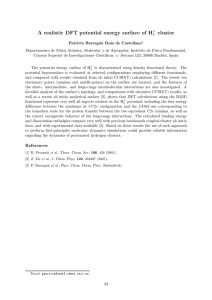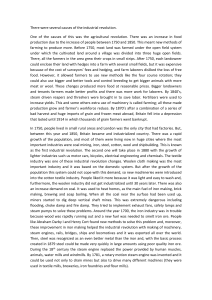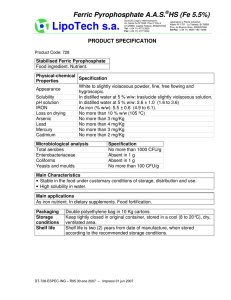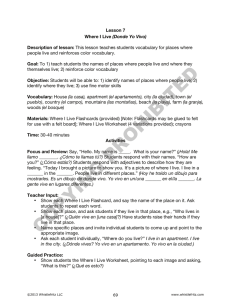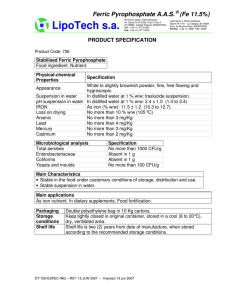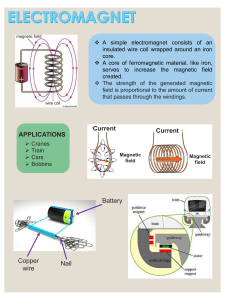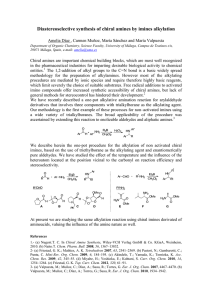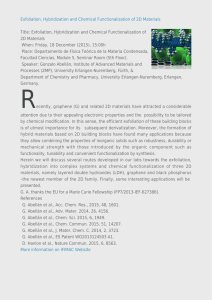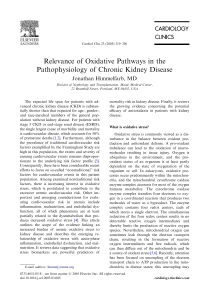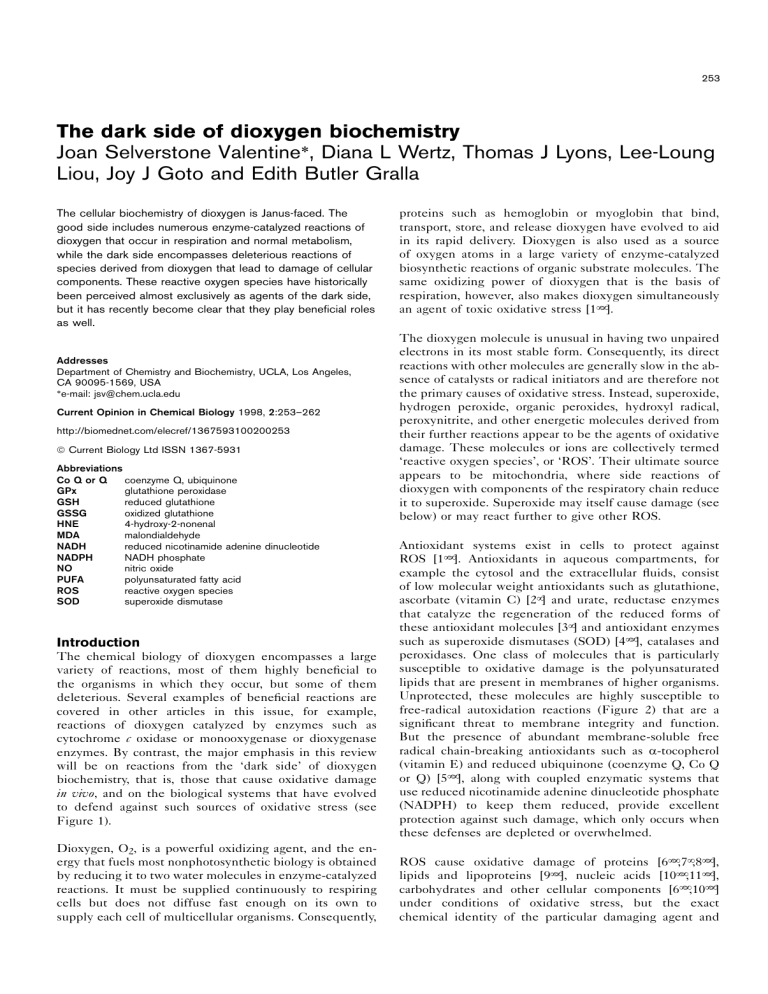
253 The dark side of dioxygen biochemistry Joan Selverstone Valentine∗, Diana L Wertz, Thomas J Lyons, Lee-Loung Liou, Joy J Goto and Edith Butler Gralla The cellular biochemistry of dioxygen is Janus-faced. The good side includes numerous enzyme-catalyzed reactions of dioxygen that occur in respiration and normal metabolism, while the dark side encompasses deleterious reactions of species derived from dioxygen that lead to damage of cellular components. These reactive oxygen species have historically been perceived almost exclusively as agents of the dark side, but it has recently become clear that they play beneficial roles as well. Addresses Department of Chemistry and Biochemistry, UCLA, Los Angeles, CA 90095-1569, USA ∗e-mail: jsv@chem.ucla.edu Current Opinion in Chemical Biology 1998, 2:253–262 http://biomednet.com/elecref/1367593100200253 Current Biology Ltd ISSN 1367-5931 Abbreviations Co Q or Q coenzyme Q, ubiquinone GPx glutathione peroxidase GSH reduced glutathione GSSG oxidized glutathione HNE 4-hydroxy-2-nonenal MDA malondialdehyde NADH reduced nicotinamide adenine dinucleotide NADPH NADH phosphate NO nitric oxide PUFA polyunsaturated fatty acid ROS reactive oxygen species SOD superoxide dismutase Introduction The chemical biology of dioxygen encompasses a large variety of reactions, most of them highly beneficial to the organisms in which they occur, but some of them deleterious. Several examples of beneficial reactions are covered in other articles in this issue, for example, reactions of dioxygen catalyzed by enzymes such as cytochrome c oxidase or monooxygenase or dioxygenase enzymes. By contrast, the major emphasis in this review will be on reactions from the ‘dark side’ of dioxygen biochemistry, that is, those that cause oxidative damage in vivo, and on the biological systems that have evolved to defend against such sources of oxidative stress (see Figure 1). Dioxygen, O2, is a powerful oxidizing agent, and the energy that fuels most nonphotosynthetic biology is obtained by reducing it to two water molecules in enzyme-catalyzed reactions. It must be supplied continuously to respiring cells but does not diffuse fast enough on its own to supply each cell of multicellular organisms. Consequently, proteins such as hemoglobin or myoglobin that bind, transport, store, and release dioxygen have evolved to aid in its rapid delivery. Dioxygen is also used as a source of oxygen atoms in a large variety of enzyme-catalyzed biosynthetic reactions of organic substrate molecules. The same oxidizing power of dioxygen that is the basis of respiration, however, also makes dioxygen simultaneously an agent of toxic oxidative stress [1••]. The dioxygen molecule is unusual in having two unpaired electrons in its most stable form. Consequently, its direct reactions with other molecules are generally slow in the absence of catalysts or radical initiators and are therefore not the primary causes of oxidative stress. Instead, superoxide, hydrogen peroxide, organic peroxides, hydroxyl radical, peroxynitrite, and other energetic molecules derived from their further reactions appear to be the agents of oxidative damage. These molecules or ions are collectively termed ‘reactive oxygen species’, or ‘ROS’. Their ultimate source appears to be mitochondria, where side reactions of dioxygen with components of the respiratory chain reduce it to superoxide. Superoxide may itself cause damage (see below) or may react further to give other ROS. Antioxidant systems exist in cells to protect against ROS [1••]. Antioxidants in aqueous compartments, for example the cytosol and the extracellular fluids, consist of low molecular weight antioxidants such as glutathione, ascorbate (vitamin C) [2•] and urate, reductase enzymes that catalyze the regeneration of the reduced forms of these antioxidant molecules [3•] and antioxidant enzymes such as superoxide dismutases (SOD) [4••], catalases and peroxidases. One class of molecules that is particularly susceptible to oxidative damage is the polyunsaturated lipids that are present in membranes of higher organisms. Unprotected, these molecules are highly susceptible to free-radical autoxidation reactions (Figure 2) that are a significant threat to membrane integrity and function. But the presence of abundant membrane-soluble free radical chain-breaking antioxidants such as α-tocopherol (vitamin E) and reduced ubiquinone (coenzyme Q, Co Q or Q) [5••], along with coupled enzymatic systems that use reduced nicotinamide adenine dinucleotide phosphate (NADPH) to keep them reduced, provide excellent protection against such damage, which only occurs when these defenses are depleted or overwhelmed. ROS cause oxidative damage of proteins [6••,7•,8••], lipids and lipoproteins [9••], nucleic acids [10••,11••], carbohydrates and other cellular components [6••,10••] under conditions of oxidative stress, but the exact chemical identity of the particular damaging agent and 254 Bio-inorganic chemistry Figure 1 (c) Damage Protein oxidation: all cell compartments (b) (d) Lipid peroxidation and toxic products: all membranes Fe Fe S Fe S S ROS HNE MDA HNE MDA S Fe O2 (a) H2O2 M OH 4Fe–4S clusters: specific enzymes n+ Mito Nucleus Cytoplasm (CuZnSOD) DNA damage: nucleus, mitochondria Vacuoles, lysosomes Plasma membrane Mito Mitochondria (MnSOD, GPx) ER and Golgi Peroxisomes (catalase) (e) O2 I Q O2- H2O2 O2 H2O in (f) SOD catalase peroxidase ascorbate GSH IV III out O2 O2- C H2O2 Aqueous compartments Vitamin E Co Q Lipid compartments Mitochondrial inner membrane ROS generation Defenses Current Opinion in Chemical Biology A schematic overview of some of the pathways leading to oxidative stress and of antioxidants that defend against them in a typical eukaryotic cell (center; mito, mitochondrion; ER, endoplasmic reticulum). There are four classes of oxidative damage: (a) Site-specific oxidative damage involving metal-catalyzed generation of hydroxyl radical from hydrogen peroxide which results in strand breaks and base damage in DNA. (Similar events could occur wherever metal ions bind adventitiously.) (b) Lipid peroxidation which damages membranes as well as producing toxic products such as MDA (malondialdehyde) and HNE (4-hydroxy-2-nonenal) which react with other cell components. (c) Damage to proteins resulting from direct oxidations by reactive oxygen species (ROS) or reactions with the products of lipid metabolism (for example, HNE, MDA). (d) Direct reactions of superoxide itself with certain iron–sulfur cluster prosthetic groups in exposed positions which result in full or partial disassembly of the cluster, inactivation of the enzyme, and release of iron. (Iron released in this manner may go on to catalyze more hydroxyl radical generation at specific locations.) (e) A schematic representing the major source of superoxide and hydrogen peroxide in the cell — leakage of electrons from the electron transport chain. I, III, and IV represent complexes I (NADH dehydrogenase), III (coenzyme Q : cytochrome c oxidoreductase) and IV (cytochrome oxidase) of the electron transport chain. Q, coenzyme Q; C, cytochrome c. (f) Defensive molecules are listed according to whether they are present in aqueous or lipid compartments. SOD, superoxide dismutase; GSH, reduced glutathione. the mechanism of its action in each case is often difficult to ascertain. Moreover, some of the products of oxidative damage to lipids and sugars react readily with proteins and nucleic acids and thus, when formed, could propagate the damage from the initial site of oxidative attack [6••]. Until recently, the best characterized of the reactions involved in biological oxidative damage were those that appear to be due to attack either of hydroxyl radical, HO., or of a metal-bound species with a similarly high degree of hydrogen atom abstraction reactivity. These ROS The dark side of dioxygen biochemistry Valentine et al. Figure 2 (a) 4 7 CO2H Linoleic acid X XH (b) 4 4 7 CO2H O2 4 (d) 7 CO2H O O PUFAH (e) α-tocopherol α-tocopheroxyl PUFA of O2– itself. In the past few years, however, targets damaged specifically by superoxide have been identified. Certain iron–sulfur cluster-containing enzymes are known to be directly inactivated by superoxide in vivo and in vitro. These include the TCA cycle enzyme aconitase and dihydroxyacid dehydratase, an enzyme involved in branched chain amino acid synthesis in Escherichia coli [14••,15]. 7 CO2H (c) 255 (f) 4 7 CO2H (g) Further degradation products: epoxides, cyclic peroxides, HNE, MDA and other PUFA fragments OOH Free-radical autoxidation reactions of polyunsaturated lipids leading to lipid peroxidation. (a) Various reactive oxygen species (ROS), denoted X., are capable of hydrogen atom abstraction from polyunsaturated lipids such as linoleic acid. (b) The resulting doubly allylic radical rearranges to (c), the conjugated monoallylic system, which reacts readily with dioxygen to form (d), the peroxyl radical ROO.. (e) Reaction with other polyunsaturated fatty acids (PUFAH) or with vitamin E (α-tocopherol) transforms the peroxyl radical into (f), the lipid hydroperoxide ROOH. In some cases (g) the peroxyl radical reacts with its own conjugated diene system to produce epoxides and cyclic peroxides. Internal diene–peroxyl radical reactivity often leads to fragmentation of the polyunsaturated lipid to give HNE, MDA, and other carbonyl containing compounds. Reproduced with permission from [86]. are generated in metal-catalyzed reactions of hydrogen peroxide [12] and are known to be capable of initiating free radical autoxidation of lipids and damaging protein and DNA when they are generated in close proximity to such sites [13••]. Superoxide anion (O2–), the one electron reduction product of molecular oxygen, is believed to be a key player in hydroxyl radical generation in vivo because its dismutation is the primary source of cellular H2O2 and possibly also because it can play the role of reducing agent for catalytic metal ions in the Fenton reaction. Superoxide on a chemical level is a rather sluggish reactant, however, and until recently there has been little hard evidence for toxicity due to direct reactions As might be expected, increases in oxidative stress cause cells to synthesize higher levels of antioxidants, antioxidant enzymes, repair enzymes, and other molecules that mitigate the effects of such stress. During the past few years, considerable progress has been made in characterizing the biochemical mechanisms involved in signal transduction and regulation of cellular responses to changes in levels of oxidative stress [16•,17,18]. Of particular interest in this area are new findings concerning the link between oxidative stress, mitochondrial function, and the signaling pathways of apoptosis (a form of programmed cell death) [19••]. Finally, the evidence linking oxidative damage to a large number of human diseases is beginning to accumulate. Dioxygen biochemistry is a large and active field and we could not hope to cover all of the important publications of the past year. Instead we have chosen those that appear to us to represent major themes of current research on biological oxidative stress. The articles that we have identified as being of special interest are those dealing with areas of research in which we believe a detailed understanding of the chemistry underlying the biological phenomena is beginning to emerge. Production of reactive oxygen species in vivo Most of the hydrogen peroxide and other ROS generated during the normal metabolism of a typical eukaryotic cell is derived from superoxide that is formed from reduction of dioxygen by components of the mitochondrial electron transport chain, primarily ubisemiquinone (QH•) in complex III and secondarily NADH dehydrogenase (complex I), in what are believed to be side reactions of electron transport (Figure 1) [20,21]. In addition, however, there also exist specialized systems whose primary purpose is to generate superoxide and ROS for use in defense systems that protect against pathogens. An example is the NADPH oxidase system found in leukocytes, which catalyzes the one-electron reduction of dioxygen by NADPH to form superoxide [22]. An oxidative burst mechanism utilizing a similar NADPH oxidase system is also observed in plants [23••]. Reactive oxygen species in regulation and signaling Cells respond to changing levels of oxidative stress by inducing or suppressing the expression of various genes ranging from those encoding antioxidant systems to those encoding components of the respiratory chain. Several 256 Bio-inorganic chemistry regulatory proteins of this type found in E. coli (for example, OxyR, SoxR and FNR [16•,17]) have been particularly well characterized with respect to the chemical reactions involved. Formation of a disulfide is believed to occur in OxyR [18] while protein-bound iron–sulfur clusters undergo redox reactions in SoxR [24••] and FNR [25••]. ROS have also been shown to function as secondary messengers in signaling pathways in higher organisms. Thus a cell may respond to a stimulus that is not due to changes in oxidative stress by generating ROS that diffuse to a target, react, and thereby transduce the signal [26,27••,28,29••]. Numerous recent studies have implicated production of ROS in the signaling pathways of apoptosis, and it is intriguing to speculate that the link may occur at the mitochondria, which are the source of most of the ROS produced in eukaryotic cells [19••,29••]. Mitochondria have recently been found to play a central role in apoptosis [30], by releasing cytochrome c into the cytosol where it causes activation of the protease caspase-3 as a part of the apoptotic pathway. In addition, ROS may play a role in modulating the mitochondrial permeability transition pore [31], which may be involved in delivery of the apoptotic signal. Antioxidant enzymes Superoxide dismutases (SODs) are antioxidant enzymes that catalyze the disproportionation of superoxide to give dioxygen and hydrogen peroxide (Equation 1) [4••,21]. SOD 2O−2 + H + → O2 + H 2 O2 (1) Peroxidases catalyze the two-electron reduction of hydrogen peroxide or organic peroxides to water and alcohol in addition to oxidized cofactor. For instance, glutathione peroxidase (GPx), which uses glutathione (GSH) as the reducing agent (Equation 2), is believed to be a major cytosolic antioxidant in most eukaryotic cells. GPx ROOH + 2GSH → ROH + H 2O + GSSG (2) Some of the most startling recent findings concerning antioxidant enzymes are the recent demonstrations that mice lacking the genes for either CuZnSOD (the cytoplasmic SOD containing Cu and Zn in its active site) [32] or cellular GPx [33] develop relatively normally; however, fibroblasts from the CuZnSOD-deficient mice are markedly more sensitive to redox cycling drugs than the wild type cells [34]. By contrast, yeast lacking the gene for CuZnSOD grow poorly in air and die rapidly in stationary phase [35], and both yeast and mice lacking the genes for the mitochondrial MnSOD have drastically reduced life spans [35–37]. Recent studies of transgenic plants with altered levels of small molecule antioxidants and antioxidant enzymes have also provided valuable information concerning antioxidant systems in those organisms [38•,39–41]. The variety of known SODs has expanded in recent years as has information concerning their properties and function(s). Two particularly novel types of SODs were recently identified: nickel-containing SODs isolated from several strains of Streptomyces [42,43•,44] and a monomeric CuZnSOD found in the periplasm of E. coli [45•]. As for function, CuZnSOD was found to protect mammalian calcineurin from inactivation in vitro [46] and yeast calcineurin from inactivation in vivo, and it was discovered that a chaperone for copper was required for proper insertion of copper into CuZnSOD in yeast [47••]. In the absence of this protein CuZnSOD is present in an inactive, copper-free form. Two bacterial genes unrelated to those known to encode SODs have been shown to rescue SOD-deficient E. coli strains [48,49]. The development of synthetic and engineered SODs has continued to advance. Two types of manganese-containing synthetic SODs, one with porphyrin ligands [50] and the other with a variety of macrocyclic ligands [51•], were shown to have activity in vivo. In an elegant example of protein redesign, Pinto et al. [52••] re-engineered the protein thioredoxin into an active iron-containing synthetic SOD enzyme. A novel antioxidant function has been proposed for surface-exposed methionine residues that may be oxidized to methionine sulfoxide, with little effect on the properties of the protein, and then be re-reduced to the thioether by methionine sulfoxide reductase [53••,54]. Oxidative damage to biological molecules Proteins Chemical studies of radical-mediated protein oxidation have demonstrated oxidative modification of protein sidechains, backbone cleavage, and protein–protein dimerization [6••,7•,8••]. Sulfur-containing sidechains are particularly vulnerable to oxidation at sulfur, but most of the other oxidative pathways lead to carbonyl-containing products such as aldehydes and ketones, which are commonly measured using the 2,4-dinitrophenylhydrazine assay for protein carbonyls [7•] (see lipids and carbohydrates section below for more discussion of the use of this reagent). Recent calculations suggest that certain amino acids are more susceptible than others to irreparable damage, and that susceptibility depends upon the conformation of the domain in which they are found. For example, serine is postulated to be repairable when contained in an α helix but not when in a β sheet [55••]. A recent report by Stadtman and co-workers [56] describes an observed increase in the surface hydrophobicity of proteins The dark side of dioxygen biochemistry Valentine et al. that occurs with aging, an effect that is attributed to radical-mediated oxidative reactions. 257 Figure 3 Fe 3+ S Perhaps the most dramatic discovery in recent years concerning mechanisms of oxidative damage in biological systems is the facile reaction of superoxide with solventexposed iron–sulfur clusters in enzymes such as aconitase and other hydro-lyase enzymes containing 4Fe–4S clusters (Figure 3) [14••,15]. The reaction of superoxide with these centers has been demonstrated to inactivate such enzymes both in vitro and in vivo and to increase levels of intracellular free iron, which can catalyze oxidative damage to DNA [57••] (see below). This mechanism is the first clear cut example of a direct reaction of superoxide, rather than of a reactive oxygen species derived from it, leading to damage of a cellular component in vivo. 3+ Fe S 2+ Fe S S Fe (a) 2+ O2– Fe 3+ S 3+ Fe S 2+ Fe S 3+ O O 2 H+ (b) S Fe Fe 3+ S 3+ (c) Possibly related is the recent observation of activation of iron regulatory protein-1 (IRP-1, which is identical to cytosolic aconitase) by hydrogen peroxide [58]. Identification of the primary sites of oxidative damage in living organisms is a major challenge since antioxidant protections differ considerably depending on the nature of the ROS and the site of attack. It is therefore important to note that products of lipid and/or carbohydrate oxidation can often react with proteins and that the resulting adducts contain carbonyl groups and therefore are reactive with 2,4-dinitrophenylhydrazine in the assay for protein carbonyls [6••,7•]. Thus detection of high levels of protein carbonyls does not necessarily indicate that the proteins themselves are being directly oxidized by ROS; the carbonyls may instead result from reactions of undamaged proteins with toxic products of lipid or carbohydrate oxidation. Methodology to identify the exact nature of protein carbonyls in biological samples is being developed to address this issue [59•]. An interesting and different type of biological reaction of HNE is its reaction as a mechanism-based inhibitor of cytochrome P450 [60]. Nucleic acids Elevated levels of oxidative stress have long been known to result in oxidation of DNA, and recent results suggest S 2+ Fe S H2O2 S Fe (e) 3+ OH OOH Lipids and carbohydrates Lipid peroxidation not only threatens the integrity and function of membranes and membranous proteins but also produces a variety of toxic aldehydes and ketones, one of the worst of which, trans-4-hydroxy-2-nonenal (HNE), is produced in high yield. HNE and malondialdehyde (MDA), another common toxic product formed upon peroxidation of lipids, are known to react via a Michael addition with nucleophilic sidechains of proteins and can result in protein cross-linking (Figure 4). Oxidative damage to carbohydrates can also produce products that are reactive with proteins and can result in damage [6••]. Fe H+ (d) Fe 3+ S Fe 3+ S 3+ 3+ Fe Fe S 2+ Fe S Fe S 2+ Fe S 3+ S S Fe 4+ O S Fe 3+ Fe H+ S 3+ 2+ Fe Fe 3+ S Fe 3+, OH S Current Opinion in Chemical Biology Hypothetical mechanism for reaction of [Fe4S4]2+ clusters with superoxide. Individual charges have been assigned to iron atoms in the figure for convenience in keeping track of redox changes, but it should be emphasized that electron density in Fe–S clusters is known to be highly delocalized. (a) Reaction of superoxide with the solvent-exposed iron center at one corner of the cube produces a ferric peroxo intermediate, [Fe4S4(O2)]+, and (b) protonation of the ferric peroxo yields (c) a ferric hydroperoxide, [Fe4S4(OOH)]2+. Decomposition of the cluster might occur by one of two indicated pathways: (d) protonation and loss of hydrogen peroxide, forming an [Fe4S4]3+ cluster which loses Fe2+ to give the [Fe3S4]+ cluster, or (e) homolytic cleavage of the hydroperoxo ligand to give hydroxyl radical and a ferryl-containing cluster, [Fe4S4(O)]2+, which could also give the [Fe3S4]+ cluster upon protonation and loss of Fe3+ and hydroxide. Adapted from [14••]. that free intracellular iron is involved in this oxidation [57••,61]. A widely accepted theory is that ‘free’ iron may bind loosely to various sites in the DNA, where it can act as a catalyst for the generation, from hydrogen peroxide, of a very reactive species that reacts with DNA in the immediate vicinity. Among the species suggested to attack DNA are hydroxyl radical, an iron ferryl radical and an iron-bound hydroxyl radical [10••]. The reactions leading to the reactive species are referred to as ‘Fenton chemistry’ and are well characterized reactions in vitro, 258 Bio-inorganic chemistry Figure 4 PUFA (a) Oxidant OH O R 4-Hydroxy-2-nonenal, (HNE): PUFA oxidation product Links between nitric oxide and dioxygen biochemistry H (b) Nuc Nuc=ε-amino group of lysine, imidazole moiety of histidine, sulfhdryl group of cysteine. Protein 1 OH O R (c) Nuc H Protein 1 (d) H2N In some cases protein–protein cross-linking may occur. Protein 2 OH N R then reduce the bound iron to the ferrous state where Fenton chemistry may then occur in close proximity to DNA bases and sugars [61]. This type of chemistry is also possible for copper ions adventitiously bound to DNA; it has been observed in vitro with NADH as reductant [62•] and would be expected to result in modified bases and/or single strand break in the local DNA. There is considerable evidence that the physiological chemistries of nitric oxide (NO) and dioxygen are intimately related. Recent results in this area that are particularly notable concern peroxynitrite and nitrosylation of protein thiols [63•]. Peroxynitrite, ONOO–, is a ROS formed from reaction of superoxide with NO. It is widely believed to be an important agent in biological oxidative damage [64•], although some questions concerning its physiological relevance have been posed in the past year [65•,66•]. Recent evidence suggests that the reaction of peroxynitrite with CO2 to give nitrosoperoxycarbonate, ONOOCO2–, may play a major role in the physiological chemistry of peroxynitrite [67•], pointing to the importance of elucidating the lifetime and reactivity of ONOOCO2– in vivo. Protein 2 Nuc H Protein 1 Current Opinion in Chemical Biology Reactions of nucleophilic protein sidechains with HNE. (a) The degradation of polyunsaturated fatty acids (PUFA) often produces toxic aldehydes and ketones such as HNE. (b) This compound is detrimental to proteins as a result of its ability to function as a Michael acceptor for various nucleophilic protein sidechains. The resulting HNE–protein adduct (c) may have an altered hydrophobicity as well as an increased carbonyl content, which will cause it to be reactive with 2,4-dinitrophenylhydrazine in assays for protein carbonyls. (d) The HNE–protein adduct is capable of reacting further with the amino groups of other proteins to produce cross-linked protein–protein adducts. Adapted from [6••]. where a redox active metal ion such as iron or copper, superoxide and hydrogen peroxide are reactants. In vivo it is less clear that superoxide is necessary, because its role in this reaction is that of a reducing agent for the metal ion, a role that could also be filled by a number of other biological molecules. Recent results, however, have led to the proposal that superoxide plays an additional role in oxidative stress — that of increasing the level of intracellular ‘free’ iron ions [10••,15], as well as acting as a reducing agent in the Fenton reaction. It is proposed that its ability to cause iron release from vulnerable 4Fe–4S clusters leads to an increased concentration of ‘free’ iron in the cell. Increases in cellular iron have recently been reported to cause iron deposition in the nucleus [57••]. Cellular reductants such as superoxide, ascorbate and NADH may Nitrosylation of thiols has been reported to result in modification of protein function [68] and to occur in signal transduction pathways [69••]. The mechanism of S-nitrosylation in vivo is currently unknown but dioxygen or ROS probably serves as the oxidant(s) in the generation of nitrosating species (Equation 3) [70•]. R − S − H + NO + oxidant → R − S − NO + ? (3) Nitric oxide has also been reported to react with proteins containing iron–sulfur clusters [71–73]. Reactive oxygen species in disease There is convincing evidence for the involvement of oxidative damage in several classes of diseases [8••], although the identity of the ROS formed, the nature of the chemical reactions involved in their formation and subsequent reactions, and the primary targets of oxidative damage are often not yet identified. In the case of diseases that lead to neurodegeneration, redox metal ion involvement has frequently been implicated [74•,75•,76,77••,78,79,80••,81]. Atherosclerosis [9••] and diabetes [82] are other diseases in which oxidative damage has been implicated. Drug action involving reactive oxygen species The pharmacological action of many drugs involves ROS. Interesting examples are isoniazid, a drug used to treat the pathogen Mycobacterium tuberculosis [83••], and the antitumor antibiotic agent leinamycin [84]. Photodynamic therapy is another example of drug action involving a ROS, in this case, singlet dioxygen, 1O2 [85]. The dark side of dioxygen biochemistry Valentine et al. Conclusions The past several years have seen significant advances in our understanding of biochemical pathways responsible for the oxidative stress and biological damage associated with various disease states and with living in air. At the same time, it has become increasingly clear that ROS, in addition to their role as toxic agents, are also used in certain signal transduction pathways, drug metabolism, and in different types of biological defense mechanisms. It has also become clear that the biochemistry of NO and O2 is often strongly linked. Most of the ROS formed in normal eukaryotic cells are derived from superoxide formed at the mitochondria. The central role the mitochondria play in cell life and cell death is undoubtedly intimately linked to dioxygen biochemistry, but remains incompletely understood to date. The details (sources, targets, exact chemical identities, and concentrations of reactive oxygen species) are subjects of active inquiry. Elucidation of the chemical mechanisms and pathways associated with oxidative damage is particularly important given the pivotal role dioxygen and ROS play in cellular biochemistry. References and recommended reading Papers of particular interest, published within the annual period of review, have been highlighted as: • of special interest •• of outstanding interest 1. •• Scandalios JG: Oxidative stress and the molecular biology of antioxidant defenses. Plainview: Cold Spring Harbor Laboratory Press; 1997. This book contains an excellent collection of review articles by several of the leaders in the field of biological oxidative stress research. It provides broad coverage of relevant topics and a welcome emphasis on plant systems. 2. • Berger TM, Polidori MC, Dabbagh A, Evans PJ, Halliwell B, Morrow JD, Roberts LJ, Frei B: Antioxidant activity of vitamin C in iron-overloaded human plasma. J Biol Chem 1997, 272:15656-15660. Ascorbate is a biological antioxidant of major importance. Nevertheless, it can act as a reductant of metal ions (such as iron and copper) that promote Fenton reactions of hydrogen peroxide to produce dangerous oxidants, it has frequently been claimed that ascorbate can, under certain conditions, act as a pro-oxidant in vivo. This paper reports evidence to the contrary indicating that ascorbate is an antioxidant and not a pro-oxidant in human plasma in vivo, even under conditions of iron overload. 3. • May JM, Mendiratta S, Hill KE, Burk RF: Reduction of dehydroascorbate to ascorbate by the selenoenzyme thioredoxin reductase. J Biol Chem 1997, 272:22607-22610. Stoichiometric antioxidants such as ascorbate and glutathione (GSH) are re-reduced and thus recycled many times in vivo. The reduction of oxidized GSH (GSSG) is catalyzed by GSH reductase. Less is known about mechanisms of reduction of dehydroascorbate to ascorbate in vivo, but it is widely believed that the biological reductant is GSH. This paper reports an alternative mechanism in which the selenoenzyme thioredoxin reductase catalyzes reduction of dehydroascorbate by reduced nicotinamide adenine dinucleotide phosphate (NADPH). 4. •• Fridovich I: Superoxide anion radical (O2-.), superoxide dismutases, and related matters. J Biol Chem 1997, 272:1851518517. This is a timely minireview of superoxide and superoxide dismutases. 5. •• Do TQ, Schultz JR, Clarke CF: Enhanced sensitivity of ubiquinone-deficient mutants of Saccharomyces cerevisiae to products of autoxidized polyunsaturated fatty acids. Proc Natl Acad Sci USA 1996, 93:7534-7539. 259 Yeast lacking coenzyme Q were hypersensitive to polyunsaturated fatty acids and lipid hydroperoxides were elevated. The hypersensitivity was rescued by addition of antioxidants. The paper provides dramatic evidence for the antioxidant action of reduced ubiquinone in vivo and of the toxicity of the autoxidation products of unsaturated fatty acids. 6. •• Stadtman ER, Berlett BS: Reactive oxygen-mediated protein oxidation in aging and disease. Chem Res Toxicol 1997, 10:485494. A comprehensive review of biochemical mechanisms of oxidative damage caused by reactive oxygen species, with emphasis on proteins as targets for such damage. 7. Berlett BS, Stadtman ER: Protein oxidation in aging, disease, • and oxidative stress. J Biol Chem 1997, 272:20313-20316. A minireview on the same subject as [6••]. 8. •• Dean RT, Fu S, Stocker R, Davies MJ: Biochemistry and pathology of radical-mediated protein oxidation. Biochem J 1997, 324:1-18. A review of radical-mediated protein oxidation with emphasis on the physiology and pathology of the resulting protein damage. 9. •• Steinberg D: Low density lipoprotein oxidation and its pathobiological significance. J Biol Chem 1997, 272:2096320966. A timely minireview of LDL oxidation. 10. •• Henle ES, Linn S: Formation, prevention, and repair of DNA damage by iron/hydrogen peroxide. J Biol Chem 1997, 272:19095-19098. A timely minireview of mechanisms of DNA oxidation catalyzed by iron. 11. Beckman KB, Ames BN: Oxidative decay of DNA. J Biol Chem •• 1997, 272:19633-19636. A timely minireview of biological DNA oxidation. 12. Wardman P, Candeias LP: Fenton chemistry: an introduction. Radiat Res 1996, 145:523-531. 13. •• Mukhopadhyay CK, Mazumder B, Lindley PF, Fox PL: Identification of the prooxidant site of human ceruloplasmin: A model for oxidative damage by copper bound to protein surfaces. Proc Natl Acad Sci USA 1997, 94:11546-11551. This paper reports the presence of a single histidine residue that is at or near the surface of the protein ceruloplasmin and that coordinates copper ions. The presence of the surface bound copper confers pro-oxidant properties on that protein. Mutagenesis of the surface histidine residue to an arginine results in the loss of this property. This study provides a precedent for surface binding of a redox-active metal by a protein that can enhance its ability to act as a catalyst of oxidative damage because of its accessibility to other components of the cell. 14. Flint DH, Allen RM: Iron–sulfur proteins with non redox •• functions. Chem Rev 1996, 96:2315-2334. A comprehensive review of the properties of such proteins, including a detailed discussion of the sensitivity of some of them to oxidation by superoxide or other oxidants. 15. Gardner PR: Superoxide-driven aconitase FE-S center cycling. Biosci Rep 1997, 17:33-42. 16. • Hidalgo E, Ding H, Demple B: Redox signal transduction via iron-sulfur clusters in the SoxR transcription activator. Trends Biochem Sci 1997, 22:207-210. SoxR contains 2Fe–2S clusters and acts as a redox-sensitive transcriptional activator. This minireview of SoxR describes recent findings and includes a comparison of regulatory proteins containing 2Fe–2S and 4Fe–4S clusters as sensors for dioxygen, superoxide, nitric oxide or other oxidants or iron. The authors point out that a potential advantage of 2Fe–2S clusters as redox sensors may be the stability of the cluster in both oxidized and reduced redox states. 17. Demple B: Study of redox-regulated transcription factors in prokaryotes. Methods 1997, 11:267-278. 18. Zheng M, Aslund F, Storz G: Activation of the OxyR transcription factor by reversible disulfide bond formation. Science 1998, 279:1718-1721. 19. Papa S, Skulachev VP: Reactive oxygen species, mitochondria, •• apoptosis and aging. Mol Cell Biochem 1997, 174:305-319. This interesting review points out that the best method to guard against reactive oxygen species formed in vivo is not antioxidants but reduction in the amount of superoxide formed at the mitochondria that subsequently reacts to give the reactive oxygen species. Topics discussed include mechanisms of superoxide formation in the cell, respiration as a tool to lower dioxygen concentrations, uncoupling as a mechanism to prevent superoxide formation, mitochondrial pores, and the link between the state of the mitochondrion and apoptosis. 260 Bio-inorganic chemistry 20. Richter C, Schweizer M: Oxidative stress in mitochondria. In Oxidative Stress and the Molecular Biology of Antioxidant Defenses. Edited by Scandalios JG. Plainview: Cold Spring Harbor Laboratory Press; 1997:169-200. 21. Gralla EB: Superoxide dismutase: studies in the yeast Saccharomyces cerevisiae. In Oxidative Stress and the Molecular Biology of Antioxidant Defenses. Edited by Scandalios JG, Plainview: Cold Spring Harbor Laboratory Press. 1997:495-525. 22. Park J-W, Babior BM: Activation of the leukocyte NADPH oxidase subunit p47phox by protein kinase C. A phosphorylation-dependent change in the conformation of the C-terminal end of p47phox. Biochemistry 1997, 36:7474-7480. Doke N, Miura Y, Sanchez LM, Park HJ, Noritake T, Yoshioka H, Kawakita K: The oxidative burst protects plants against pathogen attack: mechanism and role as an emergency signal for plant bio-defence — a review. Gene 1996, 179:45-51. Plant cells respond rapidly to infection or wounding with an oxidative burst. This review describes the mechanism of this phenomenon and its function as an internal emergency signal for active defense by the plant. Motor neurons in Cu/Zn superoxide dismutase-deficient mice develop normally but exhibit enhanced cell death after axonal injury. Nat Genet 1996, 13:43-47. 33. Ho Y-S, Magnenat J-L, Bronson RT, Cao J, Gargano M, Sugawara M, Funk CD: Mice deficient in cellular glutathione peroxidase develop normally and show no increased sensitivity to hyperoxia. J Biol Chem 1997, 272:16644-16651. 34. Huang TT, Yasunami M, Carlson EJ, Gillespie AM, Reaume AG, Hoffman EK, Chan PH, Scott RW, Epstein CJ: Superoxidemediated cytotoxicity in superoxide dismutase-deficient fetal fibroblasts. Arch Biochem Biophys 1997, 344:424-432. 35. Longo VD, Gralla EB, Valentine JS: Superoxide dismutase activity is essential for stationary phase survival in Saccharomyces cerevisiae. Mitochondrial production of toxic oxygen species in vivo. J Biol Chem 1996, 271:12275-12280. 36. Li Y, Huang TT, Carlson EJ, Melov S, Ursell PC, Olson JL, Noble LJ, Yoshimura MP, Berger C, Chan PH et al.: Dilated cardiomyopathy and neonatal lethality in mutant mice lacking manganese superoxide dismutase. Nat Genet 1995, 11:376381. 37. Lebovitz RM, Zhang H, Vogel H, Cartwright J Jr, Dionne L, Lu N, Huang S, Matzuk MM: Neurodegeneration, myocardial injury, and perinatal death in mitochondrial superoxide dismutasedeficient mice. Proc Natl Acad Sci USA 1996, 93:9782-9787. 23. •• 24. •• Ding H, Demple B: In vivo kinetics of a redox-regulated transcriptional switch. Proc Natl Acad Sci USA 1997, 94:84458449. This paper shows that the 2Fe-2S clusters of SoxR are reversibly oxidized in vivo in response to superoxide generation. This oxidation correlates with the transcriptional activity of soxS, the target of SoxR. Thus SoxR is the first transcription factor containing iron–sulfur clusters whose activity has been demonstrated to be a direct function of the redox state of the cluster. 25. •• Khoroshilova N, Popescu C, Munck E, Beinert H, Kiley PJ: Ironsulfur cluster disassembly in the FNR protein of Escherichia coli by O2: [4Fe-4S] to [2Fe-2S] conversion with loss of biological activity. Proc Natl Acad Sci USA 1997, 94:6087-6092. FNR is a 4Fe–4S-cluster-containing transcription factor that regulates a network of genes that facilitate adaptation to low dioxygen concentrations in E. coli. In this study, the transformation of the [4Fe–4S]2+ cluster of FNR into a [2Fe–2S]2+ cluster upon exposure to air in vitro was observed using electronic, EPR (electron paramagnetic resonance) and Mossbauer spectroscopies. Little 3Fe–4S cluster was observed. Thus the 4Fe–4S cluster in FNR appears to be more susceptible to direct reaction with dioxygen than the 4Fe–4S cluster in aconitase, which is oxidized rapidly by superoxide but not by dioxygen. These results suggest that the degree of reactivity of 4Fe–4S clusters toward oxidants can be modulated by their individual protein environments. 26. Bae YS, Kang SW, Seo MS, Baines IC, Tekle E, Chock PB, Rhee SG: Epidermal growth factor (EGF)-induced generation of hydrogen peroxide. Role in EGF receptor-mediated tyrosine phosphorylation. J Biol Chem 1997, 272:217-221. Irani K, Xia Y, Zweier JL, Sollott SJ, Der CJ, Fearon ER, Sundaresan M, Finkel T, Goldschmidt-Clermont PJ: Mitogenic signaling mediated by oxidants in Ras-transformed fibroblasts. Science 1997, 275:1649-1652. The GTP-binding protein Ras participates in a variety of normal cellular processes, but overexpression of Ras or mutations leading to constitutive activation of Ras can lead to tumor formation. This paper reports that fibroblasts with constitutively active Ras produced large quantities of superoxide and that addition of the antioxidant N-acetyl-L-cysteine to these cells inhibited DNA synthesis. These results imply that superoxide-derived reactive oxygen species induced by the presence of Ras act as signaling agents. 38. • Willekens H, Chamnongpol S, Davey M, Schraudner M, Langebartels C, Van Montagu M, Inze D, Van Camp W: Catalase is a sink for H2O2 and is indispensable for stress defense in C3 plants. EMBO J 1997, 16:4806-4816. In this paper the authors demonstrated that catalase deficient transgenic tobacco plants were sensitive to elevated light levels; however, this increase in sensitivity was not accompanied by an increase in hydrogen peroxide levels, but was accompanied by a decrease in ascorbate and increased levels of oxidized glutathione. They conclude that catalase functions as a cellular sink for hydrogen peroxide, including peroxide produced outside the peroxisomes. 39. Allen RD, Webb RP, Schake SA: Use of transgenic plants to study antioxidant defenses. Free Radic Biol Med 1997, 23:473479. 40. Conklin PL, Williams EH, Last RL: Environmental stress sensitivity of an ascorbic acid-deficient Arabidopsis mutant. Proc Natl Acad Sci USA 1996, 93:9970-9974. 41. Van Camp W, Inzé D, Van Montagu M: The regulation and function of tobacco superoxide dismutases. Free Radic Biol Med 1997, 23:515-520. 42. Kim EJ, Kim HP, Hah YC, Roe JH: Differential expression of superoxide dismutases containing Ni and Fe/Zn in Streptomyces coelicolor. Eur J Biochem 1996, 241:178-185. 27. •• 28. Wesselborg S, Bauer MKA, Vogt M, Schmitz ML, SchulzeOsthoff K: Activation of transcription factor NF-κB and p38 mitogen-activated protein kinase is mediated by distinct and separate stress effector pathways. J Biol Chem 1997, 272:12422-12429. 29. Polyak K, Xia Y, Zweier JL, Kinzler KW, Vogelstein B: A model for •• p53-induced apoptosis. Nature 1997, 389:300-305. The tumor suppressor protein p53 can induce programmed cell death (apoptosis). This paper shows that p53 expression induces expression of many genes with redox-related activities, followed by increased levels of oxidative stress, which is in turn followed by mitochondrial lipid degradation. These results suggest that p53 mediates apoptosis by inducing oxidative damage to the mitochondria. 30. Reed JC: Cytochrome c: can’t live with it — can’t live without it. Cell 1997, 91:559-562. 31. Scorrano L, Petronilli V, Bernardi P: On the voltage dependence of the mitochondrial permeability transition pore. A critical appraisal. J Biol Chem 1997, 272:12295-12299. 32. Reaume AG, Elliott JL, Hoffman EK, Kowall NW, Ferrante RJ, Siwek DF, Wilcox HM, Flood DG, Beal MF, Brown RH Jr et al.: 43. • Youn HD, Youn H, Lee JW, Yim YI, Lee JK, Hah YC, Kang SO: Unique isozymes of superoxide dismutase in Streptomyces griseus. Arch Biochem Biophys 1996, 334:341-348. Two unique isozymes of SOD from S. griseus are described. SOD I was composed of four identical subunits of molecular weight 13 000 kDa. It was found to contain 0.9 nickel ions per subunit. Its absorption and electron paramagnetic resonance (EPR) spectra were characteristic of Ni(III). SOD II was composed of four identical subunits of molecular weight 22 000 kDa. It was found to contain both iron and zinc. Nickel SOD was found to be widely distributed in Streptomyces. For many years it was thought that all SODs contained either Fe, Mn, or Cu and Zn. One wonders what other novel SODs will be found in the future. 44. Youn HD, Kim EJ, Roe JH, Hah YC, Kang SO: A novel nickelcontaining superoxide dismutase from Streptomyces spp. Biochem J 1996, 318:889-896. 45. • Benov L, Sage H, Fridovich I: The copper- and zinc-containing superoxide dismutase from Escherichia coli: molecular weight and stability. Arch Biochem Biophys 1997, 340:305-310. This paper reports further characterization of the periplasmic CuZnSOD from E. coli, which was found by sedimentation equilibrium analysis to be a monomer with a molecular weight of approximately 17 000 kDa. Studies of thermal inactivation of this enzyme in the presence and absence of excess copper and zinc ions suggest that these metal ions are relatively loosely held in this enzyme. Hg(II) was found to inactivate the enzyme, presumably by displacing metal ions from the active site. Not long ago, CuZnSODs were believed to be restricted to eukaryotes and one or two atypical prokaryotes. This is obviously no longer the case and new examples of prokaryotic CuZnSODs continue to be found. 46. Wang X, Culotta VC, Klee CB: Superoxide dismutase protects calcineurin from inactivation. Nature 1996, 383:434-437. The dark side of dioxygen biochemistry Valentine et al. 47. •• Culotta VC, Klomp LW, Strain J, Casareno RL, Krems B, Gitlin JD: The copper chaperone for superoxide dismutase. J Biol Chem 1997, 272:23469-23472. In this paper the authors showed that a specific protein carrier of copper, Lys7p, was required for the proper metallation of CuZnSOD in Saccharomyces cerevisiae. A lys7 knockout strain showed an oxygen sensitive phenotype characteristic of CuZnSOD deficiency. This strain contained copperdeficient CuZnSOD protein but showed normal processing of other copper proteins. The oxygen sensitivity of the lys7 knockout strain is particularly striking since both the CuZnSOD protein and the copper ions are present in sufficient amounts but the copper is not inserted into the protein. 48. Lehmann Y, Meile L, Teuber M: Rubrerythrin from Clostridium perfringens: cloning of the gene, purification of the protein, and characterization of its superoxide dismutase function. J Bacteriol 1996, 178:7152-7158. 49. Liochev SI, Fridovich I: A mechanism for complementation of the sodA sodB defect in Escherichia coli by overproduction of the rbo gene product (desulfoferridoxin) from Desulfoarculus baarsii. J Biol Chem 1997, 272:25573-25575. 50. Batinic-Haberle I, Liochev SI, Spasojevic I, Fridovich I: A potent superoxide dismutase mimic: manganese β-octabromo-mesotetrakis-(N-methylpyridinium-4-yl) porphyrin. Arch Biochem Biophys 1997, 343:225-233. 51. • Weiss RH, Fretland DJ, Baron DA, Ryan US, Riley DP: Manganese-based superoxide dismutase mimetics inhibit neutrophil infiltration in vivo. J Biol Chem 1996, 271:2614926156. This paper describes in vivo studies of several manganese-containing synthetic SODs which had previously been shown to have high SOD activity and to inhibit neutrophil-mediated cell injury in vitro. These drugs were found to inhibit colonic tissue injury and neutrophil accumulation in a dose-dependent manner. Similar manganese-containing compounds with little or no SOD activity were ineffective. These results support a proinflammatory role for superoxide in tissue injury and provide further encouragement for development of synthetic SODs as drugs. 52. •• Pinto AL, Hellinga HW, Caradonna JP: Construction of a catalytically active iron superoxide dismutase by rational protein design. Proc Natl Acad Sci USA 1997, 94:5562-5567. Thioredoxin, which does not normally bind metal ions, was redesigned to introduce a non-heme iron site into its hydrophobic interior in order to create a synthetic FeSOD. The resulting protein was found to bind Fe3+ and to have substantial SOD activity. 53. •• Moskovitz J, Berlett BS, Poston JM, Stadtman ER: The yeast peptide-methionine sulfoxide reductase functions as an antioxidant in vivo. Proc Natl Acad Sci USA 1997, 94:95859589. This paper reports identification and characterization of the enzyme methionine sulfoxide reductase (MsrA) in the yeast S. cerevisiae. Interruption of the yeast gene resulted in a null mutant, which totally lost its cellular MsrA activity and was more susceptible to oxidative stress than its wild type parent strain. Under various oxidative stresses, high levels of free and protein-bound methionine sulfoxide were found in extracts of the null mutant cells relative to their wild type parent cells. These results suggest that methionine plus MsrA constitutes an antioxidant system in which free or external methionine residues act as scavengers of reactive oxygen species followed by re-reduction of the resulting methionine residues in a reaction catalyzed by MsrA. MsrA should thus be added to the list of antioxidant enzymes in the cell. 54. Levine RL, Mosoni L, Berlett BS, Stadtman ER: Methionine residues as endogenous antioxidants in proteins. Proc Natl Acad Sci USA 1996, 93:15036-15040. 55. •• Rauk A, Yu D, Armstrong DA: Toward site specificity of oxidative damage in proteins: C–H and C–C bond dissociation energies and reduction potentials of the radicals of alanine, serine, and threonine residues — an ab initio study. J Am Chem Soc 1997, 119:208-217. This paper addresses the issue of whether the susceptibility to oxidative damage of individual amino acid residues in proteins depends upon the secondary structure in which they occur. Ab initio calculations indicated that amino acid residues in β sheet structures would be more susceptible to hydrogen atom abstraction at the α-carbon position relative to those in α-helical structures. Theoretical calculations also indicated that sensitivity increases in the series alanine <serine <threonine. Consideration of the relative bond strengths of α-carbon C–H and alkyl thiol S–H bonds indicates that glutathione will have less ability to repair α- carbon centered radicals in threonine and in β sheet structures than those in α-helical structures. 56. Chao CC, Ma YS, Stadtman ER: Modification of protein surface hydrophobicity and methionine oxidation by oxidative systems. Proc Natl Acad Sci USA 1997, 94:2969-2974. 261 57. •• Keyer K, Imlay JA: Superoxide accelerates DNA damage by elevating free-iron levels. Proc Natl Acad Sci USA 1996, 93:13635-13640. A whole cell EPR method was developed to determine relative amounts of ‘free’ intracellular iron in E. coli. The results of this study indicate that superoxide is able to leach iron from proteins containing 4Fe–4S clusters and that superoxide stress increases the amount of ‘free’ iron in cells. The increase in iron was shown to be due to leakage from 4Fe–4S clusters rather than from iron storage proteins. This paper presents data strongly supporting a mechanism for superoxide toxicity in which superoxide damage of proteins similar to aconitase containing 4Fe–4S clusters causes an increase in intracellular ‘free’ iron which then catalyzes oxidative damage of cellular components by hydrogen peroxide in the presence of cellular reducing agents. The relatively large amount of ‘free’ iron that can be detected by this method in E. coli is striking. It will be important to determine what form this iron takes in the cell (that is, oxidation state, state of aggregation, identity of any ligands) because Fe3+ itself is not soluble under these conditions. 58. Pantopoulos K, Mueller S, Atzberger A, Ansorge W, Stremmel W, Hentze MW: Differences in the regulation of iron regulatory protein-1 (IRP-1) by extra- and intracellular oxidative stress. J Biol Chem 1997, 272:9802-9808. 59. • Hartley DP, Kroll DJ, Petersen DR: Prooxidant-initiated lipid peroxidation in isolated rat hepatocytes: detection of 4hydroxynonenal- and malondialdehyde-protein adducts. Chem Res Toxicol 1997, 10:895-905. 4-hydroxy-2-nonenal (4-HNE) and malondialdehyde (MDA) are products of lipid peroxidation which are known to modify proteins through covalent alkylation of lysine, histidine, and cysteine amino acid residues. Antibodies were raised that recognize the different types of protein adducts that are formed upon reaction with these unsaturated aldehydes. Isolated hepatocytes were exposed to either carbon tetrachloride (CCl4) or iron/ascorbate. Levels of MDA and protein carbonyls increased dramatically in both cases, whereas 4-HNE levels were little changed. Immunoprecipitation experiments indicated that increases in MDA corresponded with increases in intensity and number of MDA-adducted proteins. Neither CCl4 nor iron/ascorbate elicited changes in 4-HNE or induced 4-HNE-modified proteins. Experiments of the type described in this paper will be very useful in establishing the details of oxidative damage pathways occurring in vivo. 60. Kuo CL, Vaz ADN, Coon MJ: Metabolic activation of trans4-hydroxy-2-nonenal, a toxic product of membrane lipid peroxidation and inhibitor of P450 cytochromes. J Biol Chem 1997, 272:22611-22616. 61. Meneghini R: Iron homeostasis, oxidative stress, and DNA damage. Free Radic Biol Med 1997, 23:783-792. 62. • Oikawa S, Kawanishi S: Site-specific DNA damage induced by NADH in the presence of copper(II): Role of active oxygen species. Biochemistry 1996, 35:4584-4590. DNA damage was induced by NAD(P)H in the presence of Cu(II). The damage was inhibited by catalase as well as by chelation of Cu(I) but not by hydroxyl radical scavengers. These results suggest that NAD(P)H can act as an endogenous reductant of DNA-bound Cu(II) to Cu(I) which then reacts with hydrogen peroxide to give oxidation of DNA. The oxidation is proposed to occur via a DNA-Cu(I)OOH complex or by generation of hydroxyl radicals in a site-specific manner. 63. Radi R: Reactions of nitric oxide with metalloproteins. Chem • Res Toxicol 1996, 9:828-835. A comprehensive review of reactions of NO and species derived from it with metalloproteins. 64. Beckman JS: Oxidative damage and tyrosine nitration from • peroxynitrite. Chem Res Toxicol 1996, 9:836-844. Peroxynitrite, formed from the reaction of nitric oxide (NO) with superoxide, has been implicated as a major agent of NO-induced cytotoxicity. This comprehensive review describes the experiments in support of this hypothesis. 65. • Fukuto JM, Ignarro LJ: In vivo aspects of nitric oxide (NO) chemistry: Does peroxynitrite (-OONO) play a major role in cytotoxicity? Accounts Chem Res 1997, 30:149-152. This commentary critically evaluates the hypothesis that peroxynitrite plays a major role in cytotoxicity in vivo and concludes that the evidence currently available is not sufficient to reach that conclusion. 66. • Halliwell B: What nitrates tyrosine? Is nitrotyrosine specific as a biomarker of peroxynitrite formation in vivo? FEBS Lett 1997, 411:157-160. This paper concludes that the evidence is not conclusive that nitrotyrosine is specific as a biomarker of peroxynitrite formation in vivo and suggests that the nitrating agent be referred to as a reactive nitrogen species. 67. • Lymar SV, Hurst JK: Carbon dioxide: physiological catalyst for peroxynitrite-mediated cellular damage or cellular protectant? Chem Res Toxicol 1996, 9:845-850. It has only recently been realized that peroxynitrite reacts rapidly with CO2 to form an adduct, ONO2CO2–. This reaction occurs at physiologically relevant 262 Bio-inorganic chemistry concentrations and may represent the major fate of peroxynitrite when it is formed in vivo. This paper reviews this topic and concludes that considerably more knowledge about the lifetime and reactivity of this adduct is required before its biological significance can be assessed. 68. Gergel D, Cederbaum AI: Inhibition of the catalytic activity of alcohol dehydrogenase by nitric oxide is associated with S-nitrosylation and the release of zinc. Biochemistry 1996, 35:16186-16194. 69. •• Lander HM, Hajjar DP, Hempstead BL, Mirza UA, Chait BT, Campbell S, Quilliam LA: A molecular redox switch on p21ras. Structural basis for the nitric oxide-p21ras interaction. J Biol Chem 1997, 272:4323-4326. Nitric oxide (NO) stimulates Ras by increasing its guanine nucleotide exchange activity by nitrosothiol formation. In this report the authors determine that this S-nitrosylation specifically occurs at Cys118 of the protein. Mutation of this residue to a serine prevents NO induction of guanine nucleotide exchange and two mitogen-activated protein (MAP) kinases downstream of Ras. 70. • Gow AJ, Buerk DG, Ischiropoulos H: A novel reaction mechanism for the formation of S-nitrosothiol in vivo. J Biol Chem 1997, 272:2841-2845. A mechanism for formation of S-nitrosothiols (R-SH) from NO and thiols in vivo is proposed in which NO reacts with R–SH to form RS–NOH, which reacts further with O2 to give RS–N=O plus superoxide. Chemical evidence in support of the feasibility of this mechanism is presented. 77. •• Sayre LM, Zagorski MG, Surewicz WK, Krafft GA, Perry G: Mechanisms of neurotoxicity associated with amyloid βdeposition and the role of free radicals in the pathogenesis of Alzheimer’s disease: a critical appraisal. Chem Res Toxicol 1997, 10:518-526. A comprehensive review of proposed mechanisms of neurotoxicity associated with amyloid deposition in Alzheimer’s disease. 78. Hosler BA, Brown RH Jr: Superoxide dismutase and oxygen radical neurotoxicity. Curr Opin Neurol 1996, 9:486-491. 79. Foury F, Cazzalini O: Deletion of the yeast homologue of the human gene associated with Friedreich’s ataxia elicits iron accumulation in mitochondria. FEBS Lett 1997, 411:373-377. 80. •• Rotig A, de Lonlay P, Chretien D, Foury F, Koenig M, Sidi D, Munnich A, Rustin P: Aconitase and mitochondrial iron-sulphur protein deficiency in Friedreich ataxia. Nat Genet 1997, 17:215217. Friedreich ataxia is a degenerative disease linked to mutations in the frataxin gene. This gene is believed to be involved in mitochondrial iron transport, based on studies of a homologous protein in yeast. In this report, the authors show that the activities of aconitase and complexes I, II, and III of the electron transport chain, which are Fe–S cluster containing enzymes, are reduced in heart tissue from two Freidreich ataxia patients relative to the average control activities. 71. Gardner PR, Costantino G, Szabo C, Salzman AL: Nitric oxide sensitivity of the aconitases. J Biol Chem 1997, 272:2507125076. 81. Koch KA, Pena MM, Thiele DJ: Copper-binding motifs in catalysis, transport, detoxification and signaling. Chem Biol 1997, 4:549-560. 72. Drapier J-C: Interplay between NO and [Fe-S] clusters: relevance to biological systems. Methods 1997, 11:319-329. 82. 73. Lipinski P, Drapier J-C: Interplay between ferritin metabolism, reactive oxygen species and nitric oxide. J Biol Inorg Chem 1997, 2:559-566. Elgawish A, Glomb M, Friedlander M, Monnier VM: Involvement of hydrogen peroxide in collagen cross-linking by high glucose in vitro and in vivo. J Biol Chem 1996, 271:12964-12971. Smith MA, Harris PL, Sayre LM, Perry G: Iron accumulation in Alzheimer disease is a source of redox-generated free radicals. Proc Natl Acad Sci USA 1997, 94:9866-9868. This paper reports mapping of the distribution of iron in the brain using a stain based on the Prussian blue reaction. Redox active iron was found to be associated with senile plaques and neurofibrillary tangles. This iron may catalyze in situ oxidation reactions by H2O2 and contribute to Alzheimer’s disease. Sherman DR, Mdluli K, Hickey MJ, Arain TM, Morris SL, Barry CE III, Stover CK: Compensatory ahpC gene expression in isoniazid-resistant Mycobacterium tuberculosis. Science 1996, 272:1641-1643. The catalase-peroxidase KatG in Mycobacterium tuberculosis activates the drug isoniazid to a form toxic to this bacterium. Loss of KatG function results in isoniazid resistance, but results in increased peroxide sensitivity. In this report, the authors show that isoniazid-resistant KatG mutants compensate for the loss of KatG function by mutations resulting in the overexpression of Ahp C, a putative alkyl hydroperoxidase. 75. • 84. Mitra K, Kim W, Daniels JS, Gates KS: Oxidative DNA cleavage by the antitumor antibiotic leinamycin and simple 1,2-dithiolan3-one 1-oxides: evidence for thiol-dependent conversion of molecular oxygen to DNA-cleaving oxygen radicals mediated by polysulfides. J Am Chem Soc 1997, 119:11691-11692. 85. Boyle RW, Dolphin D: Structure and biodistribution relationships of photodynamic sensitizers. Photochem Photobiol 1996, 64:469-485. 86. Halliwell B, Gutteridge JMC: Free radicals in biology, edn 2. Oxford: Clarendon Press; 1989. 74. • Multhaup G, Ruppert T, Schlicksupp A, Hesse L, Beher D, Masters CL, Beyreuther K: Reactive oxygen species and Alzheimer’s disease. Biochem Pharmacol 1997, 54:533-539. This commentary describes evidence suggesting that the presence of amyloid peptide βA4, which is derived from the amyloid precursor protein (APP), leads to oxidative stress by a mechanism that involves complexation and reduction of Cu(II) to Cu(I). The paper is marred by the failure of the authors to address satisfactorily earlier criticisms of the use of bathocuprein as a method for detection of Cu(I) formation [76]. 76. Sayre LM, Multhaup G: Alzheimer’s precursor protein and the use of bathocuproine for determining reduction of copper(II). Science 1996, 274:1933-1934. 83. ••
